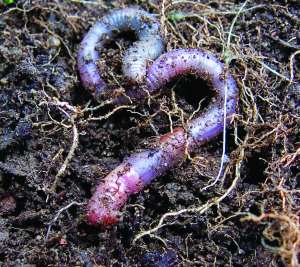In July, University of Minnesota forest ecologist Lee Frelich and Doug and Peggy Wallace, coordinators of a citizen’s monitoring group, bushwhacked up a ridge in the Wolf Lake inventoried roadless area adjacent to the Trout Lake area of the Boundary Waters Canoe Area Wilderness (BWCAW). They poured a gallon of water and ground mustard seed over a square foot area of the ground and watched.

“Sure enough, even in that remote location, there were worms, including one of the most destructive (L. Terrestris)—night crawler,” Doug Wallace said.
Only one variety of earthworm found in the Carolinas is native to the United States. Europeans introduced the rest, and in northern Minnesota, worms strip the forest floor bare. They eat through the leaf litter and leave exposed, black mineral soil behind. They also drive out native beetles that aerate the soil.
“From my personal observation, earthworms are spreading quite rapidly and in a lot of different places,” Frelich said. “Most of the invasive plants are pretty much dependent on the worms because worms create the right germination environment. They co-evolved with the worms on their home continent, so that makes sense.”
Doug and Peggy Wallace’s citizen’s group operates under an agreement with the Forest Service to monitor the Wolf Lake roadless area for invasive species, rare and endangered species, bird and raptor inventory, evidence of illegal motorized vehicle use, water quality and recreational use. In 2009, they verified the presence of earthworms using techniques recommended by Frelich. Their July hike confirmed that worms are more widespread than they thought, and the group plans to continue the survey throughout the roadless area and into the Boundary Waters to keep track of changes.
Frelich also hopes to survey the Boundary Waters region. He has applied for funding through the Legislative Citizen Commission on Minnesota Resources (LCCMR), which makes recommendations to the legislature on how to allocate funds from the Environment and Natural Resources Trust Fund.
“People have done some small surveys here and there, but this will be a more systematic survey. We would look inside and outside of the wilderness to see if what is outside is ready to come in,” Frelich said.
Frelich has already observed Buckthorn in the Ely area, and suspects there are more invasive species. With funding, he and University of Minnesota PhD students would complete a three-year survey to better understand what invasive species are present inside and out of the BWCAW, and how they are responding to climate change. The question then will be what to do about it. As Frelich points out, it may be too late for worms—the BWCAW does not have a live bait rule prohibiting its use as other wilderness areas do, and their presence is already clear. But for some species, it might
not be too late.
“I have been looking myself whenever I’ve been there and I am seeing invasive species everywhere that I go, at least worms and smaller plants. There’s no buckthorn in the BWCAW yet, so we need to get rid of it outside [of the wilderness] so it doesn’t spread into the wilderness,” Frelich said.
– By Alissa Johnson
This article appeared in Wilderness News Summer 2011

